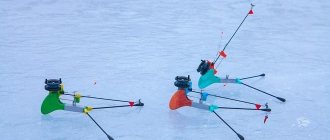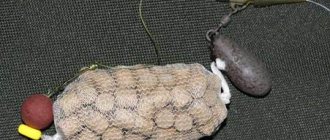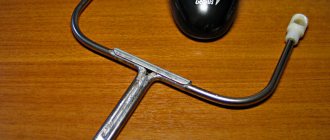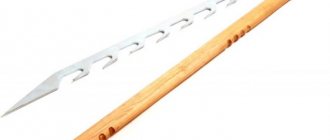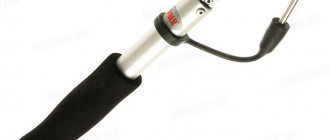What is a net for?
The purpose of the net is associated with a number of features:
- It helps bring fish to shallow water much faster, especially if it is a large specimen. The net is simply irreplaceable in the process of fishing in reservoirs where there is abundant vegetation.
- When landing trophy fish, using a net helps prevent the rod from breaking due to the heavy weight.
Many fishermen prefer not to purchase a landing net in stores, but to make it with their own hands.
This solution has a number of positive aspects:
- Store-bought products are usually made of dark-colored fishing line. In practice, this can scare away large fish and significantly reduce the quality of the catch.
- The windage of purchased nets is quite high. As a result, it is not possible to quickly bring it to the fish being caught.
- The quality of a fishing net made by yourself will be much higher. The fact is that the fisherman himself is responsible for how reliable the product will be and how long it will serve him.
- The cost of making it yourself will be significantly lower compared to a purchased product. Many fishermen refuse to purchase this product, since the price in most cases does not correspond to the quality, and from time to time they have to purchase new and new products. The production process uses mainly available materials, which significantly reduce the cost of the product.
How to fish with a net
How to catch fish with a net
A net is a mandatory attribute for catching fish. Of course, if you catch small fish, you can do without this device. But trying to pull a large fish out of the water with a fishing rod may be unsuccessful. Why don’t many fishermen buy a ready-made net for fishing in a store, but make it themselves? The fact is that the store very often sells nets with black mesh. Experienced fishermen are sure that this color of the net only scares away prey. It is better to use a mesh that is transparent in water or green, which is the most preferred color. In addition, many ready-made nets have a mesh that “sails” on the water, which only complicates the process of catching fish.
- As smoothly as possible, so as not to scare the fish, bring the net and turn its rim towards the fish.
- Do not remove the net with fish from the water. Bring it to you underwater so that the fish does not spoil the gear.
Before you buy a ready-made fishing net or make it yourself, you should know a number of requirements that apply to this attribute of a fisherman:
- When choosing a net, you should pay attention to the length of the handle. If you fish from the shore, then the handle of the net should be more than 4 meters. This is the kind of net that will allow you to catch fish without going close to the water. When fishing from a boat, such a long handle will only get in the way. Of course, the best option would be a net with an adjustable handle;
- When choosing a net, you also need to pay attention to the shape and diameter of the “head” of the net. The larger the fish you are going to catch, the larger the diameter of the net should be. The shape of the rim is not that important for many anglers, although some prefer triangular nets, arguing that they are easier to use. Other fishermen believe that the classic round net floats less on the water than nets of other shapes. Remember that it is always easier to control a net with a smaller diameter, which is especially important for novice fishermen;
- The size of the mesh of the canvas in a fishing net also matters. The larger the cells, the easier it will be to control the net underwater. This is especially important for fishing in places with strong currents. If you are fishing for small fish, the mesh size can be medium or small.
How to catch butterflies and caterpillars with a net
Even if you have never used a net to catch butterflies or caterpillars before, this process will not cause you any difficulties.
- Before catching insects with a net, you need to be sure that this is allowed in the given place. In some areas, the use of a net without special permission is prohibited.
- With the help of a net you can catch not only adult butterflies, but also caterpillars, which is even more interesting. Having caught a caterpillar, you can trace the entire development cycle of this insect.
- To make it easier to catch an insect in a net, you need to choose a net with a fairly wide rim.
- The mesh in the net should be transparent so that you can see the caught insect.
- The net must have a strong handle, since in the process of catching insects it can hit the ground.
- In order to quickly catch a butterfly or caterpillar in a net, you need to find the place of the greatest concentration of these insects. To “lure” butterflies to your site, plant plants such as buckwheat, calendula, and zinnia.
- In order to catch a butterfly sitting on a plant, sneak up behind it and throw a net with a sharp movement. Once the butterfly is in the net, quickly turn the net over so that the net covers the exit.
- You can try to catch a butterfly in flight, but it is much more difficult.
- It would be more humane to release a caught butterfly after you examine it in a net. You can keep it in the jar for a while. If you caught a caterpillar with a net, you can place it in a bucket covered with breathable material on top. If you don’t forget to feed such a “pet,” you can monitor its vital activity for a long time.
Making a net for fishing with your own hands
Materials
The easiest way is to make a non-separable net. First of all, you will need a fishing line. The amount of this material is directly dependent on the size of the product. Experienced fishermen recommend using white or light-colored fishing line so as not to scare away the fish.
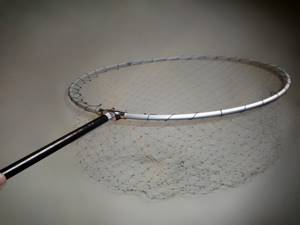
It is quite convenient to make a hoop from a duralumin tube. The ideal diameter of such an element is 9 mm.
In addition to the tube, you can use bent reeds, a regular tennis racket that is out of order, or iron wire whose diameter does not exceed 6 mm.
For the handle, dry and smooth wood of light weight is most suitable; many fishermen use ski poles or bamboo. With independent production, you won’t be able to do without cargo. It is usually made from a wire ring. It is installed in such a way that the load does not fall into the cells and does not interfere with the net opening normally when the fish approaches.
It is worth noting that the diameter of the ring should be larger compared to the diameter of the cell.
To make a bag, you need to have a number of specific skills that not every fisherman has. The easiest way is to purchase a net made of thick fishing line at a fishing store.
Build process
The sequence of actions during the manufacturing process is usually as follows:
- Weave a bag with a net or buy a ready-made mesh.
- They build a hoop on which this net will be attached.
- Make a handle for the product.
- All elements are assembled into a common structure.
How to make a net with your own hands - advantages
Whatever the purpose of the net, making it yourself has a number of advantages:
- In a homemade fishing net, you can install a mesh of the most optimal color for catching fish. It is known that a mesh that is too dark in color will only scare away fish underwater;
- the cost of a homemade net in most cases will be much less than in the store;
- If you make a net with your own hands, then make it “conscientiously.” Often, store-bought nets require regular replacement due to breakdowns, and they are quite expensive;
- If you are making a homemade net for a child, you can choose the materials you want. You can make a net of any size, adjusting it to suit different ages.
Advantages of a homemade product
- Low cost. If you produce it yourself, you will be able to save a certain amount of money, since its cost will be quite low. You will probably only have to buy fishing line, and everything else can be made from scrap materials.
- Reliability. When making a net, a fisherman immediately counts on the fish of what size and weight it will be designed for. In this regard, its reliability will be at a fairly high level. In addition, store-bought nets are usually not strong enough - their handle or ring can bend under the weight of the fish.
- Small windage. A do-it-yourself net will practically not be demolished by the current. This is largely due to the additional weight of the product. This effect allows you to very quickly place a net under the fish and pull it out of the water.
- Independent choice of color. Products sold in fishing stores are usually woven from dark wire, which can scare away the fish, causing additional flailing, and this will greatly increase the effort to remove it from the water. When making it yourself, you can use any fishing line that is most suitable.
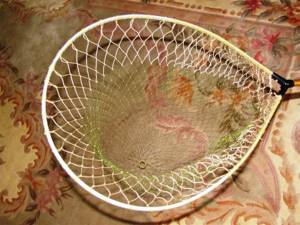
Making a net handle and a ring with fastening
Take a stick with a diameter of no more than 10-15 mm. The stick must be well processed so that both you and the child do not get a splinter in your hand. If the stick is jagged, sand it, you can coat it with varnish or drying oil.
Now we make a steel ring. Cut the wire with wire cutters. The length depends on the diameter of the ring and your preference.
The optimal length is 0.7-1m. The wire should be no more than 3 mm. Now make an arc. To make it, just wrap it around a tree trunk. Nets can be of various shapes: round, rectangular, square. But the most reliable shape of the net is a circle. This form is rigid and takes up maximum space with a minimum perimeter. In addition, the circle is also convenient because the fabric does not wear out as much as in a rectangular shape. The presence of hard corners contributes to rapid wear of the fabric. But make the hoop taking into account the fact that there should be ends with hanging fabric measuring 10-15 cm.
From the remaining ends you should make two shoulders. One shoulder should be longer than the other. Bend them down perpendicular to the circumference of the shoulder. Bend the ends of these shoulders down. Bend the ends of the shoulders inside the structure. Do this very carefully, as they can seriously injure you and your child. With the correct layout, such a structure should lie in the same plane. Attaching to the handle The attachment of the handle should be very strong, since a stick that falls off will only interfere with your activities with your child. Therefore, make the fastening strong. To make such a fastening, you must drill two holes in the handle; the depth of the holes must be at least 1 cm. Only in this way will the handle be securely fastened. Such holes need to be drilled level with the shoulders. The ends of the arms are hammered into these holes. An indicator of reliability will be that the shoulders should fit snugly to the handle. Now you need to attach them. To do this, tie them with wire to the handle. Fasten tightly.
Features of weaving fabric
Before making the bag, a shuttle is made. An aluminum or plastic sheet is suitable for it, the length of which should be about 20 cm. To facilitate work, a small hole is made in its center so that the fishing line does not unwind during the weaving process.
When weaving, you can also use an ordinary plastic ruler, the length of which will be from 130 to 160 mm. Thanks to it, you can connect nodes of any complexity, and all cells will turn out to be approximately the same size.
The sequence of work when making a bag is as follows:
- Take a ruler in your left hand, and a shuttle in your right hand, onto which the required amount of fishing line is first wound.
- With your right hand, grab a small loop and place it on the ruler, and then bring it out on the other side. The line is wrapped around your finger twice and pulled into a large loop. When all these steps are completed, you should end up with two loops on your left hand.
- The line is supported with a finger and the first loop is dropped, while simultaneously pulling up the shuttle.
- Using a ruler, they check where exactly the knot will be located, press and pull the shuttle over the ruler.
- Carefully tighten the knot.
Basic knots for knitting
When assembling a net yourself, one way or another, you have to work with fishing line, connect and intertwine it. The matter is quite simple, the main thing here is to approach this issue correctly and acquire the skill of fast and high-quality tying knots.
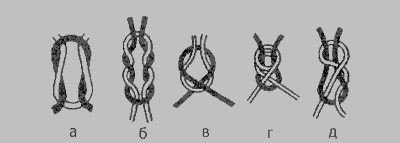
Knots for knitting nets. a – straight; b – double straight; c – clew oblique; g – double clew; d – Russian.
All units used in the fishing process must meet certain requirements, which are dictated by the practice of their use:
- The knot should be fairly simple.
- It is easy and simple to make.
- A small amount of material is spent on its production.
- It does not come undone under load.
- If the load is variable, then the knot will not creep apart, since it has a certain force.
When making your own mesh for a net, you can use several key types of nodes:
- straight;
- Russian;
- clew scythe;
- double clew.
Straight
Most often in practice you can find a straight knot, which is usually used in the process of tying a net, the cells of which are small in size. The line consumption here is not too great, and all the work takes a little time.
However, such a product has a number of disadvantages during operation:
- Over time, the mesh itself and the cells begin to deform - this primarily applies to a product made from thin fishing line.
- The holding force of such a bag is quite low.
Russian oblique with stoppers
The Russian oblique knot is the most reliable. However, in the process of its manufacture you will have to spend significantly more material and effort.
In addition, the cell sizes here will have to be immediately selected as accurately as possible. The Russian oblique knot behaves perfectly even under heavy loads, does not deform and does not intertwine.
Clew oblique knot
Knitting a clew knot is quite quick. It is characterized by low material consumption. However, it should be noted that under severe loads, the threads that are crosswise in relation to each other begin to deform. Professional fishermen do not recommend using this type of knot when making a net from fishing line or nylon threads.
Double clew
The Russian and double clew knots are considered the most reliable. Making them is not very easy, and the material consumption will be quite large. This type of knot is the most reliable, since it cannot come undone. If necessary, it can easily be converted into an ordinary double knot.
Tips for use
Catching fish by using only one net is a very serious mistake. Such an action can only lead to damage to the product. If the bait has a long handle, then it will not be very convenient to work with it while fishing.
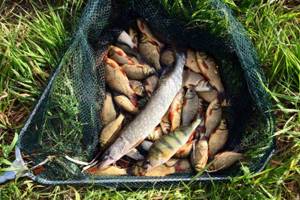
A fishing net is used only when the fish is in the water. Carrying a large fish through the air is not very easy, and there is a possibility that the handle will break off.


